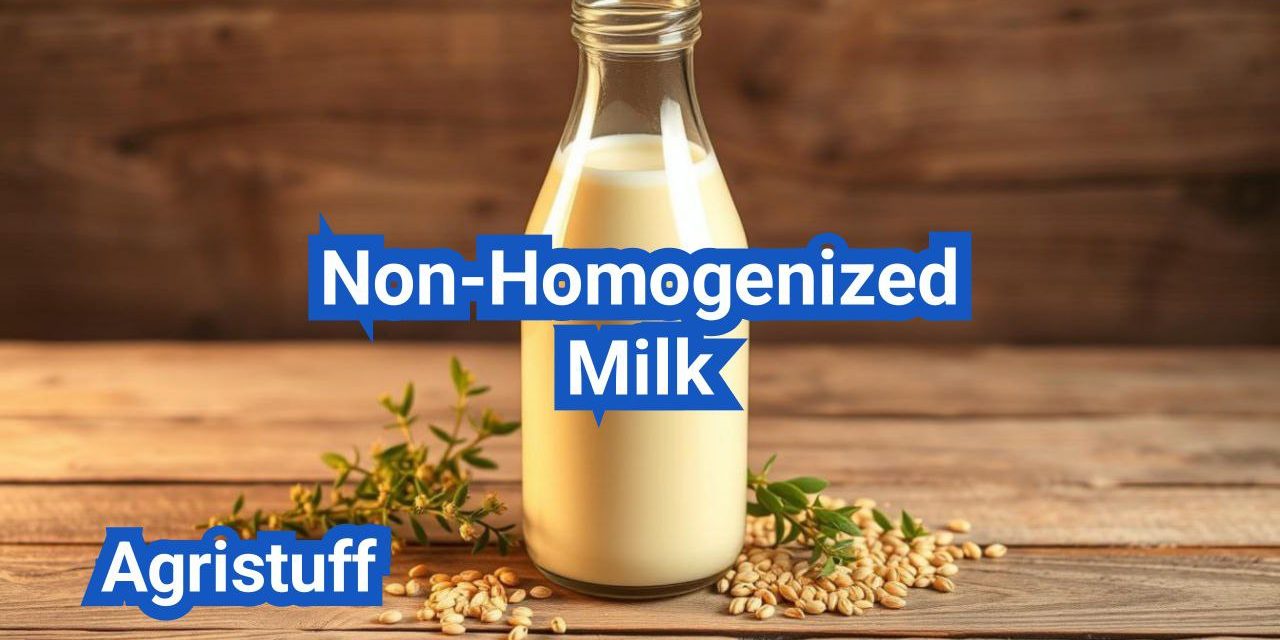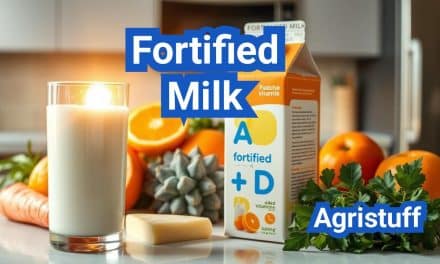Non-homogenized milk, also known as creamline or natural milk, is milk that hasn’t been processed to remove the cream layer. This results in a layer of cream separating from the skim milk when left to settle.
The natural separation in non-homogenized milk appeals to those seeking less processed dairy products. Consumers who prefer this type of milk often value its organic and natural characteristics.
Key Takeaways
- Non-homogenized milk is milk in its natural state.
- The cream layer separates from the skim milk.
- It’s preferred by those looking for less processed dairy.
- Often associated with organic and natural dairy products.
- Offers a unique texture and taste experience.
What Is Non-Homogenized Milk?
Unlike its homogenized counterpart, non-homogenized milk retains its natural cream layer. This characteristic is a result of the milk not being processed to break down the fat molecules, allowing the cream to rise to the top.
The Definition of Non-Homogenized Milk | Non Homogenized Milk
Non-homogenized milk is defined by its lack of processing to distribute fat molecules evenly throughout. This means that the cream and milk separate naturally over time, creating a distinct layer of cream on top.
Key characteristics include:
- Natural separation of cream and milk
- No artificial processing to alter fat molecule distribution
- Retains its original, unprocessed texture
The Cream-Top Characteristic | Non Homogenized Milk
The cream-top characteristic is a hallmark of non-homogenized milk. This layer of cream is not only visually appealing but also rich in flavor and nutrients.
Traditional Processing Methods | Non Homogenized Milk
Traditionally, non-homogenized milk is processed using minimal intervention methods. This includes gentle pasteurization and bottling, ensuring that the milk’s natural qualities are preserved.
| Processing Method | Description | Benefit |
|---|---|---|
| Gentle Pasteurization | Milk is heated to a temperature that kills harmful bacteria while preserving nutrients. | Retains nutritional value |
| Minimal Handling | Milk is handled minimally to prevent contamination and damage. | Preserves natural flavor and texture |
| Bottling | Milk is bottled in a way that prevents exposure to air and light. | Protects from spoilage |
By understanding the definition, characteristics, and traditional processing methods of non-homogenized milk, consumers can appreciate the value of this less processed dairy option.
The Science Behind Milk Homogenization
The science behind milk homogenization reveals the intricate processes involved in altering the physical structure of milk. Homogenization is a critical dairy processing technique that ensures the uniform distribution of fat molecules throughout milk.
How Homogenization Works | Non Homogenized Milk
Homogenization involves forcing milk through a narrow passage under high pressure, breaking down the fat globules into smaller particles. This process prevents the cream from separating and rising to the top, resulting in a consistent texture. As Dr. Harold McGee notes in his book “On Food and Cooking,” “Homogenization makes milk more convenient and aesthetically pleasing, but it also changes its physical and potentially its nutritional properties.”
The Milk Fat Globule Membrane | Non Homogenized Milk
The milk fat globule membrane (MFGM) is a complex layer of proteins and lipids surrounding the fat globules in milk. During homogenization, this membrane is disrupted, and new interfaces are formed. The MFGM plays a crucial role in the stability and digestibility of milk fat. Research has shown that the disruption of MFGM during homogenization can affect the nutritional and functional properties of milk.
Physical Changes During Homogenization | Non Homogenized Milk
Homogenization induces significant physical changes in milk. The fat globules are reduced in size, increasing the surface area and altering the interaction between fat globules and other milk components. This change can affect the overall rheological properties of milk and its behavior in various dairy products. As a result, homogenized milk behaves differently in cooking and processing compared to non-homogenized milk.
In conclusion, the science behind milk homogenization highlights the complex interactions between processing techniques and the physical structure of milk. Understanding these processes is essential for appreciating the differences between homogenized and non-homogenized milk.
Non-Homogenized Milk vs. Homogenized Milk

Understanding the differences between non-homogenized and homogenized milk is crucial for consumers making informed choices. The primary distinction lies in the processing method, which affects the milk’s taste, nutritional content, and digestibility.
Taste and Texture Differences | Non Homogenized Milk
Non-homogenized milk, also known as cream-top milk, has a richer and more natural taste due to the cream layer that rises to the top. In contrast, homogenized milk has a uniform consistency and taste because the fat molecules are evenly distributed. The difference in taste is significant for those who prefer a more traditional milk flavor.
Nutritional Comparison | Non Homogenized Milk
Both non-homogenized and homogenized milk have similar nutritional profiles if they come from the same source. However, some argue that non-homogenized milk retains more of its natural nutrients because it undergoes less processing.
| Nutritional Component | Non-Homogenized Milk | Homogenized Milk |
|---|---|---|
| Fat Content | Variable, with cream layer | Uniformly distributed |
| Protein Content | Similar | Similar |
| Vitamins and Minerals | Similar | Similar |
Digestibility Factors | Non Homogenized Milk
Some research suggests that non-homogenized milk may be easier to digest for certain individuals because the fat globules are not broken down. This can be particularly beneficial for those with sensitive stomachs.
“The natural state of milk fat globules in non-homogenized milk may offer digestive benefits for some consumers.”
In conclusion, the choice between non-homogenized and homogenized milk depends on personal preferences regarding taste, texture, and potential digestibility benefits.
Non-Homogenized Milk vs. Raw Milk
The terms ‘non-homogenized milk’ and ‘raw milk’ are often confused with one another, but they refer to different aspects of milk processing. Non-homogenized milk is milk that hasn’t been processed to break down the fat molecules into smaller, more uniform particles, resulting in a cream layer on top. Raw milk, on the other hand, is milk that hasn’t been pasteurized or heat-treated to kill off bacteria.
Pasteurization Differences | Non Homogenized Milk
One of the primary differences between non-homogenized milk and raw milk is pasteurization. Non-homogenized milk can be pasteurized, meaning it has been heated to a high temperature to kill off harmful bacteria. Raw milk, by definition, is not pasteurized. This difference is crucial for consumers who are concerned about the safety and potential health risks associated with raw milk.
Safety Considerations | Non Homogenized Milk
Safety is a significant concern when it comes to raw milk. Because it’s not pasteurized, raw milk can contain harmful bacteria like E. coli and Salmonella. Non-homogenized milk, whether pasteurized or not, doesn’t inherently carry these risks if it’s been properly pasteurized. Consumers should be aware of these safety considerations when choosing between non-homogenized and raw milk.
Legal Status in the United States | Non Homogenized Milk
The legal status of raw milk varies by state in the United States. Some states allow the sale of raw milk directly from farms, while others have stricter regulations or outright bans. Non-homogenized milk, being a matter of processing rather than pasteurization, is generally available in most states, provided it’s been pasteurized according to local health regulations.
In conclusion, while both non-homogenized and raw milk have their unique characteristics, understanding their differences is key to making informed choices. Non-homogenized milk can be a safer, more palatable option for those seeking the cream-top experience without the risks associated with raw milk.
The Benefits of Non-Homogenized Milk

The benefits of non-homogenized milk are multifaceted, ranging from improved digestibility to enhanced culinary uses. This type of milk has gained popularity among consumers seeking a more natural dairy product.
Potential Digestive Advantages | Non Homogenized Milk
Non-homogenized milk may offer digestive advantages due to its natural fat globule structure. Some research suggests that the larger fat molecules in non-homogenized milk are easier for the body to process, potentially reducing the risk of certain digestive issues.
Additionally, the natural cream layer in non-homogenized milk can help regulate the release of fat during digestion, which may be beneficial for individuals with sensitive stomachs or those who have trouble digesting homogenized dairy products.
Nutritional Benefits | Non Homogenized Milk
Non-homogenized milk retains its natural nutrients and fat-soluble vitamins, such as vitamins A, D, E, and K. The minimal processing involved in producing non-homogenized milk helps preserve these essential nutrients, making it a nutritious choice for consumers.
The fat content in non-homogenized milk is also more natural, with a better balance of fatty acids. This can contribute to a more satisfying and filling dairy experience, supporting overall nutritional well-being.
Taste and Culinary Benefits | Non Homogenized Milk
The rich, creamy flavor of non-homogenized milk is a significant advantage for culinary applications. The natural separation of cream allows for versatile uses in cooking and baking, from creating rich sauces to enhancing the texture of desserts.
Chefs and home cooks appreciate the ability to separate and use the cream as needed, adding depth and richness to various dishes. This characteristic makes non-homogenized milk an excellent choice for both everyday cooking and special recipes.
Is Grass-Fed Non-Homogenized Milk Healthier?
Recent studies have shed light on the potential advantages of grass-fed non-homogenized milk, prompting a closer examination of its nutritional profile. The notion that grass-fed dairy is healthier is supported by research highlighting its unique fatty acid composition.
Scientific Research on Non-Homogenized Milk
Studies have shown that non-homogenized milk retains its natural fat globule structure, which may offer digestive benefits. Research published in the Journal of Dairy Science suggests that the fat globule membrane in non-homogenized milk plays a crucial role in its nutritional and functional properties.
“The fat globule membrane is not just a passive barrier; it actively contributes to the nutritional and functional properties of milk.” – Journal of Dairy Science
Benefits of Grass-Fed Dairy | Non Homogenized Milk
Grass-fed dairy is rich in omega-3 fatty acids and conjugated linoleic acid (CLA), which have been associated with various health benefits, including improved heart health and immune function. A study in the American Journal of Clinical Nutrition found that grass-fed dairy products contain higher levels of these beneficial compounds compared to grain-fed dairy.
Key benefits of grass-fed dairy include:
- Higher omega-3 fatty acid content
- Increased CLA levels
- Better fatty acid profile
Making Informed Dietary Choices | Non Homogenized Milk
When considering grass-fed non-homogenized milk, consumers should weigh factors such as nutritional needs, budget, and personal preferences. While it may offer additional health benefits, it’s essential to maintain a balanced diet and consult with healthcare professionals for personalized advice.
By understanding the scientific research and nutritional benefits, consumers can make informed choices that align with their health goals and dietary requirements.
Popular Non-Homogenized Milk Brands in the USA

Several prominent dairy brands in the USA have introduced non-homogenized milk options to meet growing consumer demand. This shift reflects a broader trend towards more natural and less processed dairy products.
National Brands Like Organic Valley | Non Homogenized Milk
Organic Valley is a well-known national brand that offers non-homogenized milk. As a cooperative of organic farmers, Organic Valley has been a pioneer in providing high-quality, organic dairy products. Their non-homogenized milk is made from the milk of cows that are not treated with rBST and are fed organic feed.
Some key features of Organic Valley’s non-homogenized milk include:
- Certified organic by the USDA
- No rBST or added hormones
- Cows are fed organic feed
- Non-homogenized for a natural cream-top
Regional Producers | Non Homogenized Milk
In addition to national brands, several regional producers offer non-homogenized milk. These local dairy farms and processors often have a strong presence in their communities and may offer unique products tailored to regional tastes.
Examples of regional producers include:
- Straus Family Creamery in California, known for its organic and sustainable dairy practices
- Local dairy farms in Vermont that produce non-homogenized milk using traditional methods
Organic and Specialty Options | Non Homogenized Milk
For consumers seeking organic or specialty non-homogenized milk, there are several options available. Brands like Organic Pastures and Local Harvest offer a range of products that cater to different dietary preferences and needs.
When choosing a non-homogenized milk brand, consider factors such as the farming practices, processing methods, and certifications like “USDA Organic.” These factors can impact the quality, taste, and nutritional profile of the milk.
Where to Buy Non-Homogenized Milk

The quest for non-homogenized milk just got easier, with multiple purchasing options available across the United States. Consumers can now find this traditional dairy product in various retail outlets, both online and in physical stores.
Whole Foods and Natural Grocers | Non Homogenized Milk
Many health-conscious consumers start their search at stores like Whole Foods Market and other natural grocers. These retailers often carry a selection of non-homogenized milk products from local and national brands. Look for labels that explicitly state ‘non-homogenized’ or ‘cream-top’ to ensure you’re getting the right product.
Farmers Markets and Direct Farm Sales | Non Homogenized Milk
Farmers markets are another excellent source for non-homogenized milk. Many local dairy farmers sell their products directly to consumers through these markets. This option not only provides fresh, non-homogenized milk but also supports local agriculture. Some farms even offer direct sales from their farms, allowing consumers to buy in bulk or subscribe to regular deliveries.
Online Options and Delivery Services | Non Homogenized Milk
For those who prefer the convenience of shopping from home, online options are available. Many retailers now offer online ordering with delivery or in-store pickup. Services like Amazon and specialized dairy delivery companies provide non-homogenized milk to customers across the country. Check the product description and reviews to ensure you’re purchasing from a reputable source.
By exploring these options, consumers can easily incorporate non-homogenized milk into their diets, enjoying its unique taste and potential health benefits.
How to Properly Store and Handle Non-Homogenized Milk

To enjoy non-homogenized milk at its best, it’s essential to understand the proper methods for storing and handling it. Non-homogenized milk, with its distinct cream layer, requires careful handling to maintain its quality and freshness.
Optimal Storage Temperature | Non Homogenized Milk
Non-homogenized milk should be stored in the refrigerator at a consistent temperature of 40°F (4°C). This cool temperature slows down bacterial growth, helping to preserve the milk’s freshness and safety.
Shelf Life Considerations | Non Homogenized Milk
The shelf life of non-homogenized milk is generally shorter than that of homogenized milk due to its natural composition. It’s crucial to check the expiration date or “Sell By” date on the carton and consume it within a few days of opening. Always store it in the coldest part of the refrigerator.
Handling the Cream Layer | Non Homogenized Milk
When using non-homogenized milk, gently shake the container before pouring to redistribute the cream layer evenly. This ensures a consistent taste and texture in your recipes or when consumed directly.
By following these guidelines, you can enjoy your non-homogenized milk at its best, appreciating its unique characteristics and nutritional benefits.
Understanding Non-Homogenized Milk Nutrition

Understanding the nutritional content of non-homogenized milk can help consumers make informed choices about their dairy intake. Non-homogenized milk retains its natural nutrients, making it a valuable source of essential vitamins and minerals.
Whole Milk Nutritional Profile | Non Homogenized Milk
Non-homogenized whole milk is rich in nutrients, including proteins, fats, carbohydrates, vitamins, and minerals. A single cup of non-homogenized whole milk contains approximately 8 grams of fat, 8 grams of protein, and is an excellent source of calcium, vitamin D, and potassium.
Fat Content and Composition | Non Homogenized Milk
The fat in non-homogenized milk is primarily composed of saturated and unsaturated fatty acids. The cream layer that forms on top is rich in fat-soluble vitamins such as vitamins A, D, E, and K. The fat content is crucial for the absorption of these vitamins, making non-homogenized milk an efficient way to obtain these essential nutrients.
Vitamins and Minerals | Non Homogenized Milk
Non-homogenized milk is a good source of several important vitamins and minerals. It is particularly rich in calcium, which is crucial for bone health, and vitamin D, which aids in calcium absorption. Other minerals present include potassium, magnesium, and phosphorus, all of which play vital roles in various bodily functions.
In conclusion, non-homogenized milk offers a rich nutritional profile that includes a balanced mix of fats, proteins, vitamins, and minerals. Its natural composition makes it a nutritious choice for those looking to incorporate more whole foods into their diet.
How to Use Non-Homogenized Milk in Everyday Cooking

Non-homogenized milk, with its distinct cream layer, offers a versatile ingredient for various culinary applications. The separation of cream and milk allows for a range of uses, from enriching soups and sauces to enhancing baked goods.
Adjusting Recipes for Cream-Top Milk | Non Homogenized Milk
When using non-homogenized milk in recipes, it’s essential to consider the cream layer. You can either shake the bottle to recombine the cream and milk or use them separately, depending on the desired consistency and flavor.
Separating and Using the Cream
The cream from non-homogenized milk can be used in various ways. It can be whipped for desserts, used as a topping for coffee, or incorporated into sauces for added richness.
Best Culinary Applications | Non Homogenized Milk
Non-homogenized milk is ideal for baking, cooking, and making desserts. Its rich flavor and texture make it perfect for creamy soups, custards, and ice cream.
| Culinary Use | Benefits | Tips |
|---|---|---|
| Baking | Rich flavor, tender crumb | Shake milk before measuring |
| Cooking | Enhanced flavor, creamy texture | Use cream separately for sauces |
| Desserts | Whipped cream, creamy texture | Chill milk, then separate cream |
By understanding how to use non-homogenized milk effectively, you can elevate your cooking and baking to a new level. Experiment with different recipes and enjoy the rich, traditional taste it provides.
Making Yogurt with Non-Homogenized Milk

The process of making yogurt with non-homogenized milk is straightforward and rewarding. Non-homogenized milk, with its distinct cream layer, adds a richness and depth to homemade yogurt that is hard to achieve with homogenized milk.
Step-by-Step Yogurt Making Process | Non Homogenized Milk
To make yogurt, start by heating the non-homogenized milk to 180°F (82°C) to kill any bacteria that may be present and to denature the proteins, making the milk more conducive to yogurt culture growth. Then, let it cool to 110°F (43°C) before adding the yogurt culture. The mixture is then incubated at a warm temperature (usually around 100°F or 38°C) for several hours until it thickens and develops the characteristic tang of yogurt.
After incubation, the yogurt is chilled to stop the fermentation process. The cream layer, which rises to the top in non-homogenized milk, will add a luxurious texture to your homemade yogurt. You can either stir it in for a creamier yogurt or leave it layered for a visually appealing effect.
Equipment Needed | Non Homogenized Milk
Making yogurt at home requires minimal equipment: a saucepan for heating the milk, a thermometer to monitor the temperature, a container for incubation (such as a yogurt maker or a thermos), and a refrigerator to chill the final product.
Troubleshooting Common Issues | Non Homogenized Milk
Common issues in yogurt making include inadequate thickening or an overly tangy flavor. These can often be resolved by adjusting the incubation time or temperature. Ensuring that the milk is heated and cooled properly before adding the culture can also help achieve the desired consistency and flavor.
By following these steps and tips, you can create delicious and creamy yogurt using non-homogenized milk, enjoying the benefits of a more traditional dairy product with a modern twist.
Artisan Cheesemaking with Non-Homogenized Milk

Non-homogenized milk is preferred by many artisan cheesemakers due to its natural fat globule structure, which significantly impacts the texture and quality of the cheese. The larger fat globules in non-homogenized milk contribute to a better cheese texture, making it creamier and more palatable.
Why Cheesemakers Prefer Non-Homogenized Milk
Cheesemakers favor non-homogenized milk for its ability to produce cheeses with a richer flavor and a more appealing texture. The natural fat globules in non-homogenized milk are not broken down, allowing for a more even distribution of fat throughout the cheese, which enhances its overall quality.
Key benefits of using non-homogenized milk in cheesemaking include:
- Better texture due to the natural fat globules
- Enhanced flavor profile
- Improved overall quality of the cheese
Basic Cheese Recipes to Try at Home | Non Homogenized Milk
For those interested in trying their hand at artisan cheesemaking, there are several basic recipes to get started with. Ricotta and Mozzarella are two popular cheeses that can be made using non-homogenized milk.
To make ricotta, simply heat the non-homogenized milk to 180°F, add an acid like vinegar or lemon juice, and stir gently. The curds will separate from the whey, and you can then strain the mixture through a cheesecloth to obtain the ricotta.
Tips for Success | Non Homogenized Milk
To ensure success in artisan cheesemaking, it’s crucial to maintain proper sanitation, use high-quality non-homogenized milk, and follow tried-and-true recipes. Additionally, patience is key, as cheesemaking is a process that requires time and attention to detail.
Tips for successful cheesemaking:
- Maintain a clean and sanitized environment
- Use fresh, high-quality non-homogenized milk
- Follow recipes carefully and be patient with the process
Coffee and Non-Homogenized Milk: Creating Perfect Lattes
Non-homogenized milk brings a new dimension to coffee, enhancing both its flavor and texture. This is particularly evident when creating lattes, where the quality of the milk can significantly impact the final product.
Milk Foaming and Latte Art Techniques | Non Homogenized Milk
The cream layer in non-homogenized milk is ideal for creating rich microfoam, a crucial element for latte art. To achieve this, baristas must master the technique of steaming the milk to the right consistency. The key is to heat the milk to a temperature that allows for optimal frothing, typically between 140°F to 160°F.
Using non-homogenized milk, baristas can create intricate designs on the surface of the latte, enhancing the visual appeal of the coffee. The natural separation of cream in non-homogenized milk makes it easier to achieve the perfect microfoam, which is essential for detailed latte art.
Creating Microfoam with Cream-Top Milk | Non Homogenized Milk
The process of creating microfoam involves introducing air into the milk while heating it. With non-homogenized milk, the cream layer is particularly effective at holding air, resulting in a smooth and velvety texture. To create microfoam, baristas should use a steam wand to inject air into the milk, holding the pitcher at an angle to create a whirlpool effect that incorporates the air evenly.
Flavor Enhancement in Coffee Drinks | Non Homogenized Milk
Non-homogenized milk not only improves the texture of coffee drinks but also enhances their flavor. The cream layer adds a richness and depth that complements the coffee, creating a more balanced taste experience. By adjusting the ratio of coffee to milk and utilizing the cream layer effectively, baristas can craft unique flavor profiles that elevate the coffee-drinking experience.
Experimenting with different coffee roasts and brewing methods with non-homogenized milk can further enhance the flavor. The natural sweetness and creamy texture of non-homogenized milk allow for a reduction in added sugars and creamers, making for a healthier coffee option.
Embracing Traditional Dairy in Modern Times
Non-homogenized milk offers a more natural and less processed dairy option, providing several benefits for those seeking a traditional dairy experience in modern times. By choosing non-homogenized milk, consumers can enjoy a richer, creamier taste and potentially easier digestion.
The benefits of non-homogenized milk are multifaceted, ranging from its nutritional profile to its culinary applications. With its cream-top characteristic, non-homogenized milk is ideal for cooking, baking, and making dairy products like yogurt and cheese.
Embracing traditional dairy practices means opting for a more authentic dairy experience. Non-homogenized milk from reputable brands like Organic Valley and regional producers allows consumers to connect with the dairy’s heritage.
By incorporating non-homogenized milk into daily routines, individuals can appreciate the unique qualities of this traditional dairy product. Whether used in coffee, cooking, or enjoyed on its own, non-homogenized milk provides a delicious and wholesome choice for those looking to embrace traditional dairy in modern times.
FAQ
What is non-homogenized milk?
Non-homogenized milk is milk that has not been processed to break down the fat molecules into smaller particles, allowing the cream to separate and rise to the top.
Is non-homogenized milk the same as raw milk?
No, non-homogenized milk is not necessarily raw milk. While some non-homogenized milk may be raw, it can also be pasteurized. Pasteurization and homogenization are two separate processes.
What are the benefits of drinking non-homogenized milk?
Non-homogenized milk offers several benefits, including potential digestive advantages, higher nutritional retention, and enhanced culinary uses due to its cream-top characteristic.
How do I store non-homogenized milk?
Non-homogenized milk should be stored in the refrigerator at a temperature of 40°F (4°C) or below. It’s also important to handle the cream layer gently to prevent separation.
Can I use non-homogenized milk for making yogurt or cheese?
Yes, non-homogenized milk is often preferred for making yogurt and cheese because its natural fat globules contribute to a richer texture and flavor.
Is grass-fed non-homogenized milk healthier?
Grass-fed non-homogenized milk may offer additional health benefits due to its potentially higher content of omega-3 fatty acids and conjugated linoleic acid (CLA), although more research is needed to confirm these benefits.
Where can I buy non-homogenized milk?
Non-homogenized milk can be found in various stores, including Whole Foods, natural grocers, and some farmers’ markets. It may also be available through online retailers and direct farm sales.
How do I make latte art with non-homogenized milk?
To create latte art with non-homogenized milk, you’ll need to foam the milk, taking care to incorporate the cream layer. This can result in a richer, more velvety microfoam.
What is the nutritional profile of non-homogenized milk?
Non-homogenized milk is a good source of fat-soluble vitamins (A, D, E, and K) and minerals like calcium and phosphorus. Its nutritional profile can vary depending on factors like the cow’s diet.
Can I use non-homogenized milk in cooking and baking?
Yes, non-homogenized milk can be used in a variety of recipes, and its cream layer can be separated and used as heavy cream, adding richness to dishes.
Is non-homogenized milk pasteurized?
Non-homogenized milk can be either pasteurized or raw, depending on the producer. Pasteurized non-homogenized milk is a safer choice for those concerned about bacterial contamination.
What are some popular brands of non-homogenized milk?
Some popular brands of non-homogenized milk include Organic Valley, as well as regional and local dairy producers that may offer non-homogenized options.
Conclusion of: Non-Homogenized Milk In USA
What is non homogenized milk?
At its simplest, non homogenized milk is regular cow’s milk that has not been mechanically homogenized, so the cream naturally rises to the top and forms a “cream line.” This is why non homogenized milk is often labeled “cream-top” or “creamline.” You still get the same milk—just in its traditional, unblended structure—with a rich cream layer you can shake back in or spoon off for coffee and cooking. Michigan State University Extension explains “non-homogenized”/“creamline” labeling.
How homogenization changes milk—and why non homogenized milk is different
Homogenization breaks large milk-fat globules into many smaller ones and disperses them evenly so cream doesn’t float. By skipping that step, non homogenized milk keeps larger fat globules, a natural cream layer, and a subtly different mouthfeel that many people describe as rounder and more layered. University of Guelph’s Dairy Science & Technology e-Book details the homogenization process.
Pasteurization vs. homogenization: safety and structure are not the same
It’s essential to separate safety from texture: pasteurization is a heat treatment that kills harmful microbes; homogenization is a mechanical mixing step that affects texture and appearance. You can buy non homogenized milk that is fully pasteurized (and thus safe) as well as raw (which carries documented health risks). CDC clarifies pasteurization and the risks of raw milk.
Flavor and mouthfeel: why some shoppers prefer non homogenized milk
Many consumers choose non homogenized milk for its cream-top experience and classic dairy character. Because the fat globules remain larger, the palate sensation can feel richer, and the cream line lets you customize—from spooning cream for coffee to shaking it back for whole-milk balance. DairyNutrition (educational resource by Dairy Farmers) explains how homogenization affects sensory traits.
Nutrition: does non homogenized milk have different nutrients?
Short answer: no meaningful difference. Homogenization does not add or remove nutrients; it redistributes fat. That means non homogenized milk has substantially the same macronutrients and vitamins as its homogenized counterpart at the same fat level. U.S. Dairy notes homogenization doesn’t change milk’s nutrition or safety.
Why the cream rises: the physics behind non homogenized milk
In non homogenized milk, larger fat globules are buoyant and rise over time, forming a visible cream layer. Homogenization reduces globule size and increases surface area, slowing creaming. If you want a uniform glass from non homogenized milk, just shake gently to re-disperse the cream. University of Guelph explains creaming and fat-globule behavior.
How to use and pour non homogenized milk (shake or spoon the cream)
Before pouring non homogenized milk, you can either shake the bottle to blend the cream back in, or skim a spoonful of cream for coffee and desserts. Shaking doesn’t harm the milk; it just mixes the fat back through so your glass tastes even. Iowa State University Extension notes creamline milk should be shaken to redistribute fat.
Safety note: choose pasteurized non homogenized milk
For everyday drinking, choose pasteurized non homogenized milk to enjoy the cream-top style while maintaining food safety. Raw milk can harbor pathogens; pasteurization reduces risk without meaningfully changing nutritional value. FDA’s overview dispels myths and emphasizes raw-milk risks.
Non homogenized milk in coffee: foam and crema considerations
Baristas can absolutely steam non homogenized milk, but expect a different foam profile because larger fat globules and the intact fat-globule membrane influence bubble formation. You may get slightly less foam volume than with well-homogenized milk, but a luxurious texture if you integrate the cream well. A university study on milk foams discusses homogenization and foam properties.
Yogurt making with non homogenized milk
Home yogurt makers often enjoy the layerable texture of non homogenized milk, which can yield a top cream cap and distinct body, while homogenization tends to produce finer, more uniform gels. Technique still matters—heat treatment, culture choice, and incubation time all shape results. Research on homogenization shows how fat-globule changes affect yogurt gel structure.
Cheesemaking: when to favor non homogenized milk
Many artisan makers prefer non homogenized milk for traditional styles because intact fat globules and native membranes promote classic curd behavior. Homogenization can increase moisture retention and change curd firmness—useful in certain cheeses—but it also alters the microstructure. University of Guelph’s cheesemaking text compares milk treatments and curd properties.
Cooking and baking: sauces, custards, and desserts
For white sauces, puddings, and custards, homogenized milk can feel slightly thicker at equal fat due to smaller globules and protein–fat interactions; conversely, non homogenized milk offers classic dairy flavor with a silkier, old-school feel. Choose based on the texture you want; both cook beautifully when handled properly. DairyNutrition outlines sensory effects of homogenization in cooking.
Label reading: fat level and standards for “milk”
Whether homogenized or not, whole non homogenized milk must still meet the U.S. standard of identity for “milk,” including not less than 3.25% milkfat in the final package for beverage use and pasteurization or ultra-pasteurization. Creamline is a texture description, not a loophole in fat standards. See 21 CFR §131.110 (Milk) for federal standards.
Shopping tips: how to choose non homogenized milk
When buying non homogenized milk, look for “cream-top” or “creamline” on the label, check the fat level you prefer (whole, reduced-fat, etc.), confirm pasteurization, and note the date and storage instructions. If you like to spoon cream for coffee, choose glass bottles with a visible cream layer. MSU Extension explains common dairy label terms.
Storage and shelf life: keep it cold
Handle non homogenized milk like any fluid dairy: keep it at or below 40°F (4°C), close it promptly after pouring, and don’t return warmed milk to the jug. Cold, steady temperatures help preserve flavor and freshness, whether the milk is homogenized or cream-top. FDA advises keeping refrigerators at or below 40°F.
Myth-busting: health claims about homogenization
You might read sweeping claims online, but evidence does not support the idea that homogenization harms health; it’s a mechanical process, not a chemical one. Choosing non homogenized milk is mainly about flavor, texture, and culinary preference—not about avoiding nutrients or safety issues. U.S. Dairy confirms homogenization doesn’t change nutrition or safety.
Who might prefer non homogenized milk?
If you love skimming cream for coffee, crave a heritage dairy experience, or enjoy making yogurt and cheese at home, non homogenized milk is a great fit. If you need ultra-consistent foam for latte art or completely uniform texture in sauces, you might choose homogenized milk instead. Learn how processing influences milk performance.
How to pour perfectly every time
For a balanced glass, gently invert or shake non homogenized milk 2–3 times to blend the cream, then pour. For richer coffee, open the bottle without shaking and spoon off a little cream first. Either way, refrigerate promptly so the cream line stays clean and fresh. Iowa State University Extension reminds consumers to shake creamline milk.
Best uses at a glance
Use non homogenized milk when you want old-fashioned flavor and flexibility: cappuccinos with a touch of real cream, silky puddings, naturally layered yogurt, and artisan cheeses with classic curd behavior. Keep a bottle on hand for weekend pancakes and custards too. Guelph’s cheesemaking text links milk structure to curd traits.
Final thought
Choosing non homogenized milk is really choosing a different milk experience—one that puts you in control of texture and taste. If you love the idea of spoonable cream and classic dairy character, cream-top is a smart, delicious pick—just keep it cold and select pasteurized options for everyday safety. CDC milk safety basics.
Sources & References
- 21 CFR §131.110 — Milk (standard of identity)
- CDC — Raw Milk: Risks and safety
- FDA — Raw Milk Misconceptions & Danger
- FDA — Are You Storing Food Safely? (40°F guidance)
- U.S. Dairy — What Is Homogenized Milk?
- DairyNutrition — Why milk is homogenized & sensory effects
- University of Guelph — Homogenization of Milk & Milk Products
- University of Guelph — Milk Lipids & Fat-Globule Structure
- University of Guelph — Treatment of Milk for Cheese Making
- NIH/PMC — Yogurt quality and homogenization effects
- University of San Diego — Effect of Homogenization on Milk Foam










